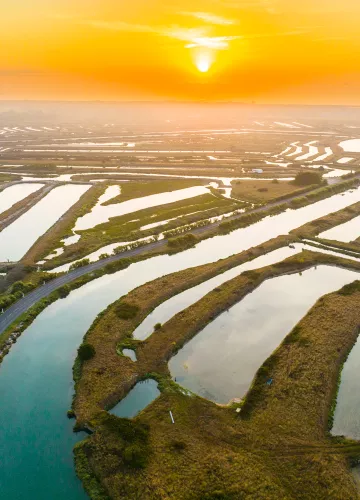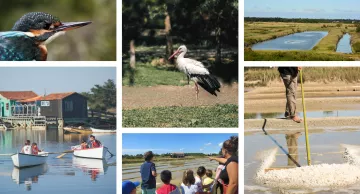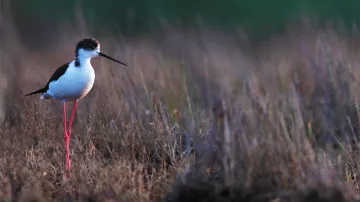
Echappées Nature nature sites
The île d’Oléron now has two Echappées Nature sites - the Marais aux Oiseaux and the Port des Salines. The main aim of these two sites is to raise visitors’ awareness of the environment and the local natural heritage. The national nature reserve of Moeze Oléron has a similar objective. It’s the number one site in France for wintering waders and one of the top five sites for ducks – much to the delight of birdwatchers!
Echappées Nature - a concept that exists nowhere else in France
The Département of Charente-Maritime has created a concept that exists nowhere else in France - Echappées natures, protected natural habitats governed by a quality charter which brings together different partners - the Conseil general (the representative assembly at département level), local authorities, the Conservatoire du Littoral and wildlife conservation charities. These natural sites feature reception facilities and special events for the general public. Two Echappées Nature sites have been created in the Marennes-Oléron region.
First opened in 1983, the goal of the Marais aux Oiseaux in Dolus d'Oléron is to familiarize the wider public with local wildlife. It contains over 600 specimens of more than 60 different species. The 30 hectares site includes a discovery area where wild and domesticated animals may be seen and a rescue centre for injured or ill wild birds. The Marais aux Oiseaux’s educational discovery trail starts off at the miniature farm. This venue gives kids the chance to get up close with different domesticated animals such as goats, donkeys and sheep. A little further along the path you will encounter wild animals. Here you can enjoy spending time with ducks, herons and egrets in their own natural habitat. An observation tower offering panoramic views over the site offers an excellent opportunity to birdwatch.

Located in Grand-Village-Plage, the Port des Salines is a place to enjoy and learn about saltmarshes. Built around old oyster shacks, the site presents the story of salt production and those who work in this industry via guided tours through an operational saltmarsh and an eco-museum housed in one of the huts. Inside, young and old can discover all about the world of salt and the marshes in a way that’s fun: educational models, a fun discovery trail and kids’ workshops. It’s possible to hire boats and enjoy a trip through the saltmarshes that’s quite unique. An interpretive trail that begins at the eco-museum and which is accessible all year round will soon reveal all the secrets of ‘white gold’.
The Moëze-Oléron nature reserve
Located on the East Atlantic flyway migration route, the Réserve Naturelle Nationale de Moëze-Oléron is a site of real importance for waterbirds, as can be seen from its position as the number one site in France for wintering waders and one of the top five sites for ducks. Covering both land and sea, it welcomes 80,000 waterbirds every winter. Parts of the reserve cover some of the île d'Oléron, specifically from the south of Boyardville to Château d'Oléron. A total of 14 km of coastline is protected by the reserve. It offers the chance to explore a very wide variety of habitats (mudflats, salt-meadows, old salt-marsh and wet meadows) encompassed by this unique place - in addition to a wealth of wildlife. You’ll soon know all there is to know about bar-tailed godwits, sandpipers, pintails and barnacle geese, amongst others!

Although the reserve’s main visitor centre is located in Saint-Froult (Pays Rochefortais), there are nonetheless various educational guide-led activities which take place on the île d'Oléron all year round. Don’t forget to check out the Réserve Naturelle Moëze-Oléron’s programme of events for more details. You can also take a 1.4 km-long interpretive trail ‘from the Citadelle du Château d’Oléron to the pointe des doux’ starting from the beach at the northern entrance of the citadel and going all the way to the pointe des doux. The return path follows the same route. This path is only open to those on foot and is open all year round. Dogs are not permitted.